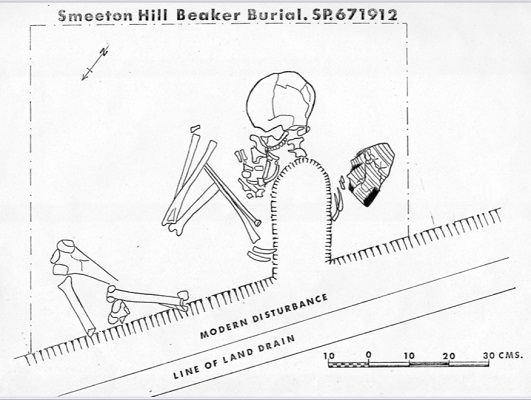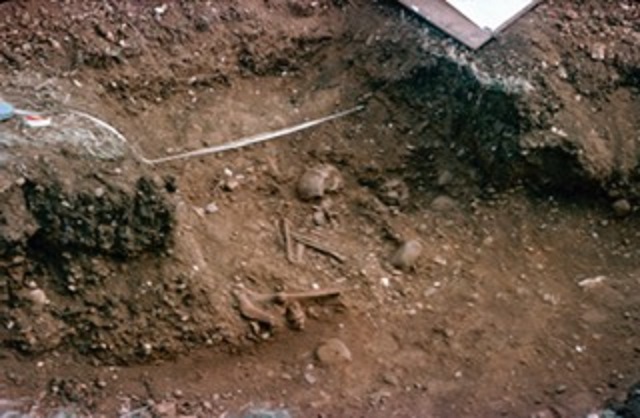Sunday 11 February 2024
The Smeeton Westerby Beaker burial revisited
Almost 50 years ago, an ancient Beaker burial was found on Smeeton Hill in south Leicestershire. LAHS Vice-President, Dr Patrick Clay takes a fresh look at how far our understanding of late Neolithic/ early Bronze Age Leicestershire has come since then.
In August 1975 a Beaker burial was found on Smeeton hill, Smeeton Westerby in south Leicestershire. The farmer was mole draining and hit an obstruction so he dug a hole to see what was the problem and found human remains. Leicestershire Museums were contacted and Bob Rutland, the Keeper of Archaeology, conducted an investigation which revealed a crouched burial with a Beaker vessel and copper alloy awl. At this time l was working for Leicestershire Archaeological Unit on medieval and Roman sites in Leicester and was lucky enough to be sent out to help plan and record the Smeeton discovery. This was my ‘Road to Damascus’ moment that captivated my fascination with Leicestershire’s prehistory. I found the discovery extremely evocative. There in front of me were the skeletal remains of someone who had lived in this part of Britain over 4000 years ago. I was hooked.
The in situ skeletal material was identified by Ann Stirland to be of a circa 30 year old male although sieving of disturbed material from the mole draining revealed evidence of six other individuals, another Beaker vessel and an antler spatula. The in situ burial was radiocarbon dated to 1490 bc +/- 50 which using the modern calibration curve is circa 2200 BC. The two Beaker vessels were of Wessex-Middle Rhine styles. Way back in 1975 Leicestershire’s prehistory and the Neolithic and Bronze Age in particular was a pretty blank canvas. As Bob Rutland surmised in his report on the site: ‘…the Midlands were largely avoided by Beaker people and Leicestershire continued to be sparsely inhabited throughout the prehistoric period.’

Twenty-five years ago l published a paper in Transactions on the Neolithic and Bronze Age of the county and by then our perception of the period had changed enormously mainly through the fantastic contribution of Pete Liddle’s Community Archaeology groups which had found extensive evidence of the area being occupied from flint scatters even on the heavy clay soils, previously thought to have remained forest until the Roman period. Special mention should be made of the Lutterworth group led by Brian Burningham, the Rutland Fieldwork group led by Elaine Jones and of course Pete’s own extensive survey centred on Medbourne. In addition far more fieldwork had been undertaken as part of the planning process which had led to new discoveries including the causewayed enclosure at Husbands Bosworth, and a barrow excavation at Lockington associated with two gold armlets, two Beaker vessels and a Breton style dagger.
Since then there have been several more significant finds from the Late Neolithic notably two settlement sites associated with Grooved Ware at Rothley, occupation associated with Beaker pottery at Asfordby and a Neolithic mortuary enclosure at Melton Mowbray. A rare pair of Late Neolithic gold earrings with affinities with Iberian examples have been found by metal detecting at Gilmorton. The picture that is emerging is that Leicestershire and Rutland were extensively if not intensely occupied in the late Neolithic and that the evidence was there but in areas of plough zone you had to look harder to find it.
Finally let us go back to the Smeeton Beaker burial. Our understanding of the Beaker phenomenon has undergone a remarkable transformation in the last decade due to DNA analysis. Beaker pottery is seen to have originated in Iberia and spread into central Europe from there but without evidence of a significant movement of people. Skeletons from Beaker burials in Iberia are not genetically close to those found in Central European. There has been a debate over whether the appearance in Britain of Beaker pottery marked the arrival of continental migrants around 2400-2200 BC or whether they were as a result of the introduction of a 'Beaker package' of objects rather than people - an exchange of new cultures and ideas - as appears to have been the case with the spread of the culture from south-west to Central Europe.

The Smeeton burial was able to contribute in a small way to a major project led by Professor Mike Parker Pearson. As part of the research over 300 skeletons were subjected to isotope analysis to explore patterns of mobility and diet, and 150 new radiocarbon dates were obtained. In contrast to the spread of the Beaker culture from Iberia to Central Europe, Britain saw significant population changes. Beaker culture had been taken up by a group of people living in Central Europe whose ancestors had previously migrated from the Eurasian Steppe. This group continued to migrate west and finally arrived in Britain around 4,400 years ago. The DNA data suggests that over a span of several hundred years, the migrations of people from continental Europe led to an almost complete replacement of Britain's earlier inhabitants, the Neolithic communities who were responsible for huge megalithic monuments such as Stonehenge.
The DNA also shows that the new migrants would have had generally different pigmentation to that of the population they replaced, who had olive-brown skin, dark hair and brown eyes. In comparison, the Beaker folk brought genes with significant reduction in skin and eye pigmentation, with lighter skin, blue eyes and blonde hair becoming more common in the population. The genetic data provided convincing evidence for immigration by Continental Beaker users, while the isotopic data indicate a more detailed picture of movements, mostly of fairly short distances within Britain, by the descendants of these first migrants.
The project exemplifies the huge strides made in
applying scientific methods to archaeological research over the past 50 years
which have revolutionised the discipline. The contrast of the perception of the
Late Neolithic we had then and how we see the period now, following the impact
of the new methodologies, is stunning.
Dr. Patrick Clay
Further Reading
Clay, P., (1999). The Neolithic and Bronze Age in Leicestershire and Rutland Transactions of the Leicestershire Archaeological and Historical Society. 63, 1-18.
Harvey, J. R., (2011). A Neolithic Mortuary Enclosure at Leicester Road, Melton Mowbray. Transactions of the Leicestershire Archaeological and Historical Society 85 ,1-20.
Hughes, G., (2000). The Lockington Gold Hoard. An Early Bronze Age Barrow cemetery at Lockington, Leicestershire. Oxford: Oxbow Books.
Hunt, L., and Clay, P. (2016). Late Neolithic Art and Symbolism at Rothley Lodge Farm, Leicester Road, Rothley (SK 592 140). Transactions of the Leicestershire Archaeological and Historical Society 90, 13-66.
Jarvis, W., (2012). Late Mesolithic and Beaker Assemblages from Excavations at Loughborough Road, Asfordby. Transactions of the Leicestershire Archaeological and Historical Society 86, 1-36.
Olalde, I., et al (2018) The Beaker phenomenon and the genomic transformation of northwest Europe. Nature555, 190–196.
Parker Pearson, M., Sheridan, A., Jay, M., Chamberlain, A., Richards, M., and Evans, J., (Ed’s). (2019)The Beaker People: Isotopes, Mobility and Diet in Prehistoric Britain. Prehistoric Society Research Paper 7.
Rutland, R. (1974). A Beaker Burial at Smeeton Westerby, Leicestershire. Transactions of the Leicestershire Archaeological and Historical Society50, 46-48.
Speed, G., (2015) Neolithic Settlement and Special Deposits at Temple Grange, Rothley, Leicestershire. Transactions of the Leicestershire Archaeological and Historical Society89, 1-36.
The Beaker burial under excavation (1975). Photo courtesy of Leicestershire County Council Museums. (with thanks to Helen Wells).


